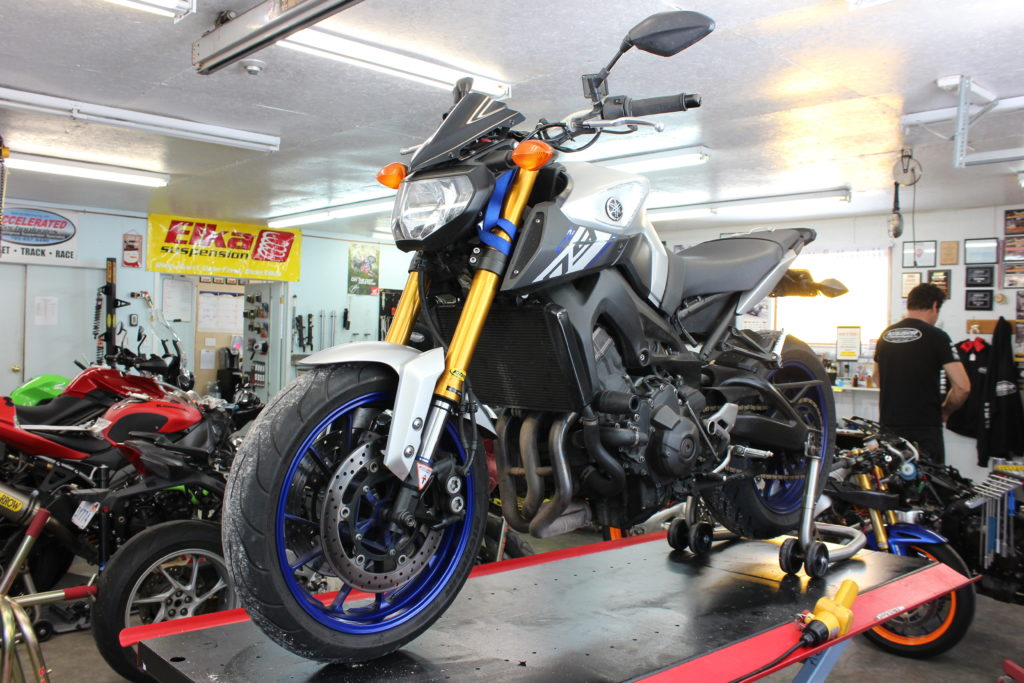Spring Season Preparation

As I write this, spring is in the air. Although the nights are still -2 below zero in our neck of the woods, it gets up to a balmy 10 degrees above during the day. So, I figured that it was high time I lifted the snow shovels off my bike and get her ready for another season of abuse. Who knows, maybe I can help shed some light on the basics of preparing your bike for the season.
When I was a kid, I often questioned my Mom as to her motives on some topic and she would respond “Do as I say… not as I do.” Mechanics sometimes fall into this behavioural trait as well, at first glance; you may think auto mechanics must take such good care of their cars. In my experience I have learned the awful truth. Due to their elevated knowledge of exactly how everything about the vehicle works, they can bring it oh so much closer to the brink of death and keep it there for month after month. They know exactly what they can get away with and what really truly needs attention. Most people hear a new noise and head off to the dealer right away, a good mechanic will hear it and say “ Hmmm… worse when it’s cold, must be a little piston slap, better go with a heavier oil and sell it before next winter.” Let’s rise above this ability and give our bikes the love they so rightly deserve after a long cold winter.
Before we put our collective trusty steed away in the fall, I know we all filled the tanks up to the brim with fuel, to limit the condensation that ‘breathes’ in and out every time the shed warms and cools. We then put in a good fuel stabilizer, mixed it up a bit and ran it until it was through the carbs or injection system. For good measure we then drained the float bowls if our bike has carbs. We changed the oil. I know we all removed the battery and put it in the basement or garage and threw it on the charger once a month (in a well ventilated area of course). I know we all put it up on its centre stand or tried to get the wheels off the ground somehow. Otherwise the cold ground and months of 500 lbs. sitting in one spot will put flat spots on the tires. After finding an airbox full of dog kibble years ago, I now plug the pipe and the airbox inlets as well to keep out the mice. Some people tell me their winter maintenance schedule is as follows “I just fire her up once a month to make sure she still runs”. Have you ever noticed in the winter in traffic that some vehicles will drip water and puff the white condensation from the exhaust pipe? Until the engine, exhaust gases and exhaust system get truly hot; they don’t burn off this condensation from a cold start. So firing your bike up for a minute or two, or even five does way more harm than good. Not only is it needless polluting, but this brief heat cycle fills the pipe, catalytic converter, and muffler packing up with water just in time for you to shut it off and walk away for a month. So avoid the temptation to disturb her sleep, leave her until spring. Another ounce of prevention is to spray the chain, engine and all moving control parts (other than the brake rotors) with a good clean lubricant that displaces moisture and prevents corrosion. Another good idea is to clean and wax the bodywork. Try not to cover the bike with anything like a tarp that wont breathe, especially if the floor gets wet during the early spring thaws.
Now the spring… Go ahead and reinstall the battery, wiping off the terminals and making sure they are clean. Clean the bodywork again and wipe away any excess or over spray from the lubricant you sprayed on in the fall. Wipe the pipes off well or your spray will burn off, causing some aromatic concerns. Lube your cables and the pivots for your levers and pedals. If you were diligent and drained the carbs, did you close the float bowl drain screws? Spraying contact cleaner on a rag and wiping off the brake rotors is a good idea as the rear rotor can often get coated from misdirected chain lube. While you are right there, peek in at the brake pads. Is the wear on all the pads the same? If not, a piston might be sticking or the caliper bracket might be seizing if it is not an apposed piston design (this is more common in a car, but can happen on older bikes too). Check your brake fluid level, low level is rarely due to a leak, but almost always due to worn out pads. The calipers are typically just held on by two bolts. If you suspect that the pads may need closer inspection or measuring, remove the calipers and measure the remaining brake pad material. All service manuals should give you a minimum thickness for this remaining brake pad material. If you are not comfortable with working on your brakes, please take it to a reputable dealer for their inspection. If you can get the front wheel off the ground, hold the bottom of the forks and gently pull the forks toward you, then try and move the wheel for and aft in between the forks. If you can feel any play or hear a clunk, find it! Excessive play may be found in the steering head, fork bushings, or wheel bearings, none are tolerable. If you can get the back of the bike off the ground, do the same with the rear wheel. Lift it straight up, paying attention to the amount of play you notice. There may often be some, as there are top and bottom shock mounts and two, three or more suspension linkage bearings that all might have a tiny bit of clearance. But any excessive movement must be investigated. Spin the tires slowly, roughness may indicate some rusty bearings, if the rotors drag, release, drag and release, they may be warped out of tolerance. Any entry-level amateur racer will have their shock and forks serviced every season, pros far more often. On the street, annually would be great, but every two years would be an acceptable maximum. Not only does the oil get dirty from parts wearing and dirt ingested by the seals, but the oil viscosity will fall off over time, leaving your damping rates diminished. I have even seen rust attack steel parts inside the fork above the oil line over the winter. Check your coolant and oil levels. Lastly check your tires for tread depth, ensure the sidewalls aren’t cracked and check the pressures before that first ride. Also remember that just because you and your bike are ready, the road will still be dirty from the winter sand and salt, and the car drivers aren’t watching for us yet either… give them time and be safe!
